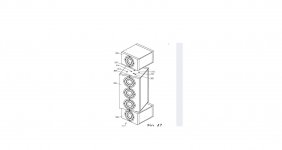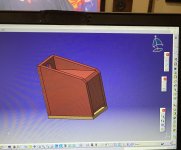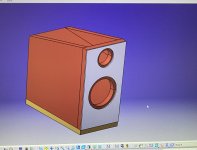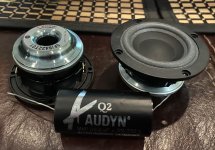So I'm about to start my first diy build. I have a TPA3116D2 2.1 Channel amp and I ordered a lot of 12 Boston Acoustic drivers from the satellites of old BA635 2.1 computer speakers. They are 2" full range 4 ohm. I have a few options at home as far as suvwoofer drivers, or I might buy one, but first I want to decide on how to build the arrays. I have access to woodworking tools and some woodworking knowledge. Budget is tight, less than$100 to get everything else I might need.
I've been reading about the different styles of array and there is so much information my head is spinning. I was originally going to build 4, 5, or 6 driver vertical line arrays for the sats but now I think I'm leaning towards a bessel array. Or maybe a horizontal array, soundbar with subwooer. Will the lack of tweeters hurt the quality of my build significantly? I'm not opposed to adding some but need some guidance on selection and building crossover. If I go with the vertical (or horizontal) line array I can wire 3 pairs in series (down to 2 ohms) and wire the pairs in parallel for a 6 ohm load. I can wire 2 pairs in parallel and wire the pairs in series for a 4 ohm load. Or I can use 5 drivers and I'm not sure what amp load that would give me. Please any advice or recommendations would be much appreciated.
I've been reading about the different styles of array and there is so much information my head is spinning. I was originally going to build 4, 5, or 6 driver vertical line arrays for the sats but now I think I'm leaning towards a bessel array. Or maybe a horizontal array, soundbar with subwooer. Will the lack of tweeters hurt the quality of my build significantly? I'm not opposed to adding some but need some guidance on selection and building crossover. If I go with the vertical (or horizontal) line array I can wire 3 pairs in series (down to 2 ohms) and wire the pairs in parallel for a 6 ohm load. I can wire 2 pairs in parallel and wire the pairs in series for a 4 ohm load. Or I can use 5 drivers and I'm not sure what amp load that would give me. Please any advice or recommendations would be much appreciated.
I'll comment on some of the easier bits:
1) A plain flat array running full range with no shading/crossover/delay on the drivers is very directional in the long axis - VERY. I tried that with 4 Dayton ND64's, planning to use them on the side of a monitor. I was expecting it to be directional, but the extent still surprised me. If you aren't planning to sit with your head in a vise, I wouldn't use a simple array of these proportions.
2) Most small full-range-ish drivers lack a little air/detail in the extreme treble. That's where adding a tweeter might help. If that doesn't concern you, you can do without it. I use the Dayton ND64's running about 250 Hz and up for the mid/treble in my desk speakers, and for casual listening, I don't notice the lack of a tweeter. In critical listening/direct comparison to high quality speakers/headphones it is noticeable, but not a deal breaker as far as I'm concerned. You can only cram so many speakers into a small space, so losing the tweeter was a reasonable trade-off to me.
1) A plain flat array running full range with no shading/crossover/delay on the drivers is very directional in the long axis - VERY. I tried that with 4 Dayton ND64's, planning to use them on the side of a monitor. I was expecting it to be directional, but the extent still surprised me. If you aren't planning to sit with your head in a vise, I wouldn't use a simple array of these proportions.
2) Most small full-range-ish drivers lack a little air/detail in the extreme treble. That's where adding a tweeter might help. If that doesn't concern you, you can do without it. I use the Dayton ND64's running about 250 Hz and up for the mid/treble in my desk speakers, and for casual listening, I don't notice the lack of a tweeter. In critical listening/direct comparison to high quality speakers/headphones it is noticeable, but not a deal breaker as far as I'm concerned. You can only cram so many speakers into a small space, so losing the tweeter was a reasonable trade-off to me.
Last edited:
I am working on a set of desktops using a 2" Scanspeak and a Kartesian SUB120_vHP-8. Going to cross them at 700Hz and leave the top baffle open. I will close the baffle later if I don't like the sound.So I'm about to start my first diy build. I have a TPA3116D2 2.1 Channel amp and I ordered a lot of 12 Boston Acoustic drivers from the satellites of old BA635 2.1 computer speakers. They are 2" full range 4 ohm. I have a few options at home as far as suvwoofer drivers, or I might buy one, but first I want to decide on how to build the arrays. I have access to woodworking tools and some woodworking knowledge. Budget is tight, less than$100 to get everything else I might need.
I've been reading about the different styles of array and there is so much information my head is spinning. I was originally going to build 4, 5, or 6 driver vertical line arrays for the sats but now I think I'm leaning towards a bessel array. Or maybe a horizontal array, soundbar with subwooer. Will the lack of tweeters hurt the quality of my build significantly? I'm not opposed to adding some but need some guidance on selection and building crossover. If I go with the vertical (or horizontal) line array I can wire 3 pairs in series (down to 2 ohms) and wire the pairs in parallel for a 6 ohm load. I can wire 2 pairs in parallel and wire the pairs in series for a 4 ohm load. Or I can use 5 drivers and I'm not sure what amp load that would give me. Please any advice or recommendations would be much appreciated.
Attachments
I would actually love to add tweeters, I'm just not really familiar with building crossovers. Oz-Robotics has a DSP chip that costs $20 but I haven't heard of anyone using it. It uses SigmaStudio software. Would that be of any help? I'm starting to think I might go with a soundbar design. Is 6 FR drivers (wired parralel/series for 6 ohm load) and tweeter(s) per channel ideal?I'll comment on some of the easier bits:
1) A plain flat array running full range with no shading/crossover/delay on the drivers is very directional in the long axis - VERY. I tried that with 4 Dayton ND64's, planning to use them on the side of a monitor. I was expecting it to be directional, but the extent still surprised me. If you aren't planning to sit with your head in a vise, I wouldn't use a simple array of these proportions.
2) Most small full-range-ish drivers lack a little air/detail in the extreme treble. That's where adding a tweeter might help. If that doesn't concern you, you can do without it. I use the Dayton ND64's running about 250 Hz and up for the mid/treble in my desk speakers, and for casual listening, I don't notice the lack of a tweeter. In critical listening/direct comparison to high quality speakers/headphones it is noticeable, but not a deal breaker as far as I'm concerned. You can only cram so many speakers into a small space, so losing the tweeter was a reasonable trade-off to me.
DSP is nice, but it adds amplifier channels if you want to do a lot with it. Do you have the budget for that? Or are you just talking about using DSP for basic equalization?
SigmaStudio looks like one of the easier ways to implement DSP at a custom circuit level, but I haven't used it personally.
"Ideal" is hard for anyone else to judge for you. Speaker designs are always a series of compromises, and it's up to the designer to make them. There are no perfect speakers.
To give you reasonable suggestions, a better idea what you are trying to accomplish would be helpful.
What exactly do you want the six 2-inch drivers to do that one of them can't?
Do you have the ability to measure the drivers (impedance and frequency response)?
Do you want to learn about crossovers/turn this into a hobby or do you just want to build one speaker project?
Many smaller speakers with arrays of drivers in them are either doing complex DSP or they are crossing over the drivers differently by area to avoid the beaming discussed earlier. Very large line arrays don't have the same issues.
I have not looked thoroughly into Bessel arrays, but this comment makes me wonder about their suitability for something like a computer speaker.
https://www.pearl-hifi.com/06_Lit_A...ns/Effective_Performance_of_Bessel_Arrays.pdf
"A working distance of 20 times the length of the Bessel array was assumed"
SigmaStudio looks like one of the easier ways to implement DSP at a custom circuit level, but I haven't used it personally.
"Ideal" is hard for anyone else to judge for you. Speaker designs are always a series of compromises, and it's up to the designer to make them. There are no perfect speakers.
To give you reasonable suggestions, a better idea what you are trying to accomplish would be helpful.
What exactly do you want the six 2-inch drivers to do that one of them can't?
Do you have the ability to measure the drivers (impedance and frequency response)?
Do you want to learn about crossovers/turn this into a hobby or do you just want to build one speaker project?
Many smaller speakers with arrays of drivers in them are either doing complex DSP or they are crossing over the drivers differently by area to avoid the beaming discussed earlier. Very large line arrays don't have the same issues.
I have not looked thoroughly into Bessel arrays, but this comment makes me wonder about their suitability for something like a computer speaker.
https://www.pearl-hifi.com/06_Lit_A...ns/Effective_Performance_of_Bessel_Arrays.pdf
"A working distance of 20 times the length of the Bessel array was assumed"
This is definately turning into a hobby. After this I would like to build maybe a pair of floorstanding speakers or OB.DSP is nice, but it adds amplifier channels if you want to do a lot with it. Do you have the budget for that? Or are you just talking about using DSP for basic equalization?
SigmaStudio looks like one of the easier ways to implement DSP at a custom circuit level, but I haven't used it personally.
"Ideal" is hard for anyone else to judge for you. Speaker designs are always a series of compromises, and it's up to the designer to make them. There are no perfect speakers.
To give you reasonable suggestions, a better idea what you are trying to accomplish would be helpful.
What exactly do you want the six 2-inch drivers to do that one of them can't?
Do you have the ability to measure the drivers (impedance and frequency response)?
Do you want to learn about crossovers/turn this into a hobby or do you just want to build one speaker project?
Many smaller speakers with arrays of drivers in them are either doing complex DSP or they are crossing over the drivers differently by area to avoid the beaming discussed earlier. Very large line arrays don't have the same issues.
I have not looked thoroughly into Bessel arrays, but this comment makes me wonder about their suitability for something like a computer speaker.
https://www.pearl-hifi.com/06_Lit_Archive/15_Mfrs_Publications/Harman_Int'l/AES-Other_Publications/Effective_Performance_of_Bessel_Arrays.pdf
"A working distance of 20 times the length of the Bessel array was assumed"
I'm going to build an enclosure like this that deals with the beaming issues by turning the 2 outer drivers according to this thread by Patrick Bateman.
https://www.diyaudio.com/community/threads/an-improved-array.301259/

How do I wire a 5 driver array? My driver are 4 ohms. Can I connect the 3 center drivers and 2 outer in parallel groups and then the 2 groups in series? If so what impedance would that create?
If you want to make it into a hobby, I would suggest adding tools as you can absorb their use.
1) crossover modeling software - XSim is free and will do frequency response simulation off axis. It will help you for this and future projects. It doesn't acoustically model open baffles. You can still use it for crossover work on them though, since you would normally be using measured driver response on your baffle. There are other options, of course.
2) measurement software - REW is the free one that's often used, and there are threads here on its functions. I don't use it personally though, so can't provide any guidance on it.
How you wire the array is going to depend on your design for it.
As you know, resistances in series add. Resistances in parallel add reciprocals, then you take the reciprocal of that sum. Your three central drivers in parallel would give you 1.3 ohms because the calculation is 1/(1/4 + 1/4 +1/4). Your two outer drivers in parallel would be 2 ohms. So total load with those two groups in series would be 3.3 ohms. If you just wire directly, you'll also have more power in the two outer drivers (over 2x).
1) crossover modeling software - XSim is free and will do frequency response simulation off axis. It will help you for this and future projects. It doesn't acoustically model open baffles. You can still use it for crossover work on them though, since you would normally be using measured driver response on your baffle. There are other options, of course.
2) measurement software - REW is the free one that's often used, and there are threads here on its functions. I don't use it personally though, so can't provide any guidance on it.
How you wire the array is going to depend on your design for it.
As you know, resistances in series add. Resistances in parallel add reciprocals, then you take the reciprocal of that sum. Your three central drivers in parallel would give you 1.3 ohms because the calculation is 1/(1/4 + 1/4 +1/4). Your two outer drivers in parallel would be 2 ohms. So total load with those two groups in series would be 3.3 ohms. If you just wire directly, you'll also have more power in the two outer drivers (over 2x).
- Home
- Loudspeakers
- Multi-Way
- Help with DIY 2.1 channel desktop speakers with 5 or 6 speaker mini line array as satellites


